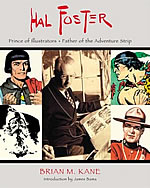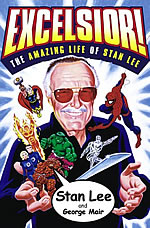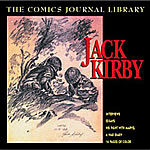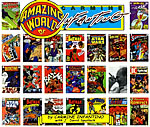PG Tips No. 10:
Paul Gravett's Recommended Reading
In a regular series of PG Tips articles, Paul Gravett reviews books of and about comics from his recommended reading list.
Hal Foster: Prince of Illustrators, Father Of The Adventure Strip
by Brian M. Kane
Vanguard
$19.95
When it comes to comic creator celebrity, for me one photograph says it all in Brian M. Kane’s new book, Hal Foster: Prince of Illustrators, Father of the Adventure Strip (ISBN 1-887591-25-7). It shows Foster (1892-1982) sitting down as guest of honour at a fancy banquet and shaking hands with one of his biggest fans, Edward, Duke of Windsor. The richly illustrated historical romance of Foster’s Prince Valiant Sunday pages were truly ‘fit for a King’, or at least for a former King, who had given up the throne to marry the love of his life, in what could almost be a surprise plot twist straight out of the Valiant comic strip In other photos Foster mingles among Hollywood and Broadway stars and is féted on This Is Your Life. Moving in these sorts of high society circles was far removed from his modest, outdoorsy upbringing in the Canadian port of Halifax, Nova Scotia, but somehow, as Kane shows, fame never went to his head. From his boyhood adventures to his lifelong devotion to his wife Helen, Foster always preferred the simpler pleasures of family life and nature, especially the sea. When he gave up illustrating Prince Valiant in 1971 after 1,764 episodes, he and his wife left behind their six-acre home, complaining that "The woods are now full of celebrities. You can shoot a gun in any direction and hit a couple of them…not a bad idea, I sometimes think." The Fosters relocated to a lakefront property in Florida, not so that Hal could retire and go fishing, but to continue writing and colouring the strip for John Cullen Murphy for another nine years, until his health failed him.
At the outset, the refinement of classical illustration for magazines and advertisements was Foster’s first aspiration, not the earthier slapstick and soap opera of the newspaper strip. His artwork for a 10-week, 300-panel adaptation of the first Tarzan book in 1928 was no more than another assignment, after which he resumed his commercial illustration work. He might never have committed himself to developing the fresh American genre of the realistically drawn adventure strip, had he not seen his investments and his advertising clients all but wiped out by the stock market crash in 1929 and the subsequent Great Depression. Hired back to take over the Sunday Tarzan page, Foster generously shared his $75 earnings equally between his letterer, inker, background penciller and researcher. As Foster came to realise the potential of the comics to bring imaginative visual fiction to a mass readership, he took greater pride in his work. He brought a fine arts approach to the drawing and layout of comics, avoiding speech balloons and insisting on colouring his pages himself to intensify mood and atmosphere. Disputes over a salary raise for his increasingly popular Tarzan pages spurred him to create a feature of his own and in 1937 Prince Valiant was born.
Available in paperback and in regular and signed 200-page hardbacks with a bonus portfolio, Kane’s book is part biography, part tribute, part critique, part scrapbook. Kane has been able to draw on Foster’s private archives, choosing drawings, photos, mementos, even charming notes of affection to his wife, as well as quotations from letters and articles, and recollections of his family, friends and peers. Some might have preferred to see more examples of his Tarzan and Prince Valiant strips, but these have been wholly reprinted by NBM and Fantagraphics and much of the lesser known and previously unseen art shown here is fascinating, from early adverts and magazine covers to his Mountie calendar paintings and personal Christmas cards. While there is less biographical detail in his later years, in no small part because Foster never kept a journal and his wife’s diaries were cremated with her, Kane turns instead to Foster’s letters and interviews to analyse his views on writing and drawing comics.
But beyond the history and techniques, what appeals to me the most are the many touching anecdotes from the adventure of Foster’s life. One that struck me particularly concerned Foster’s son, the appropriately named Arthur. Devastated when his wife deserted him for another man, Arthur disappeared without a trace after the Second World War. Eventually, when all else had failed, Foster reached his lost son through the Prince Valiant strip itself. Hal knew Arthur was reading it, wherever he was, so on the page for January 1st 1950 he changed a young squire’s name to ‘Arf’, his nickname for his son, and addressed him directly by working in the dialogue, "Arf, Arf, my boy, that awful woman is gone. You are free to come home!" That page reunited them. Arthur went on to assist his father on background inking and colouring of the strip for ten years, and in other circumstances, he might have taken over Prince Valiant, for example as Dean Young took over Blondie from his father Chic. But Hal and Arthur quarrelled and fell out over page rates, not speaking to each other except via Helen and only reconciling years later in 1971. Families can be like that and those truths may explain in part why over time Prince Valiant became as much, if not more, about relationships and family life as about swordplay and derring-do. Elegantly presented, perceptively written, what emerges from Kane’s book is as intimate a portrait as we are likely to get of this humble, humorous and hard-working man, who transformed one page every week of the comic section into stirring American illustration and adventure fiction for millions of readers, whether Kings or commoners.
Excelsior! The Amazing Life of Stan Lee
by Stan Lee & George Mair
Boxtree
£18.99
These days, after Walt Disney and Charles Schulz, surely the one American comics creator that most of the British and American public have heard of must be Stan Lee. And to most people Lee alone created all the Marvel heroes. His 246-page hardback autobiography, Excelsior! The Amazing Life of Stan Lee (ISBN 0-7522-6185-1), with additional commentary by George Mair, was cunnningly timed to coincide with this year’s blockbuster Spider-Man movie. It’s snappily written, has some cool photos with corny captions, but to your average Marvel fan offers few surprises or revelations. I did learn that Smiling Stan doesn’t really smoke, likes typing standing up in the sun on his terrace, feels poorly treated by publisher Martin Goodman and apparently has not made his fortune from the Marvel characters. I can offer one clarification: when Lee refers to a Wertham acolyte called ‘Legman’, with whom he debated once during the early 1950s comics scare, this must have been the radical theorist Gershon Legman, author of the essay collection Love And Death in 1949, which included ‘Not For Children’, his assault on the glorification of violence in comic books. And Lee trots out that hoary old wives’ tale again about Spidey being premiered in what was supposedly the final issue of Amazing Fantasy #15, when Will Murray and other experts have shown that the title could not have been cancelled at that time.
Lee doesn’t shy away from the controversies surrounding the acknowledgement of the roles of Steve Ditko and Jack Kirby in creating the Marvel Universe. He does go on record to say, "Well, despite my own opinion of what constitutes a character’s ‘creation’, my respect for Steve is so great, and his contributions to the strip were so important, that I’m willing to share the credit and call myself the co-creator. In fact, I’m willing to call myself the co-creator of all the characters I’ve dreamed up, thereby sharing a grateful world’s plaudits and accolades with the artists who did me so proud." As for Kirby, I’d not heard that Lee had repeatedly offered him an executive staff job on salary at Marvel, if he were to take over Lee’s art director duties. But Kirby always preferred to stay freelance. And as Lee speculates, if Kirby had agreed, with two such strong-willed personalities, "who knows what problems might have arisen?" Lee has always been a winning raconteur, but I can’t help feeling we need somebody else other than him to write his biography, authorised or not.
The Comics Journal Library, Volume 1: Jack Kirby
edited by Milo George
Fantagraphics Books
$18.95
For a different perspective on Jack Kirby‘s relations with Lee and with Marvel, I strongly recommend The Comics Journal Library, Volume 1: Jack Kirby, edited by Milo George (ISBN 1-56097-434-6), whose 136 pages, 12 inches square, compile the Journal’s interviews with and essays on ‘The King’ and coverage of his struggle and victory in the 1980’s to have his artwork returned. Minor quibbles about occasional murky image quality and ho-hum design aside, it’s a substantial resource. For future Libraries, how about Kurtzman, Barks and Kane for starters?
The Amazing World of Carmine Infantino
by Carmine Infantino & J. David Spurlock
Vanguard
$19.95
Over at Marvel’s suit-and-tie Brand Ecch competitors DC in the late Sixties and early Seventies, Lee’s counterpart as editorial director and then publisher was the tough, multi-talented Italian Carmine Infantino, just over two years his junior. Unlike Lee, smoking wasn’t a pose for him; as DC boss, Infantino was never without his favourite stogie. Not a household name, he too has written his autobiography with J. David Spurlock in The Amazing World of Carmine Infantino (ISBN 1-887591-12-5), published as a 176-page landscape paperback and a hardback with an additional picture section. His no-nonsense, first-person narrative conjures up the shifting fortunes and growing skills of his sixty years in the industry. Money was tight in the Infantino household surviving the Depression, making it impossible for him to pursue his dream of becoming an architect; instead, he drew his buildings in comics, learning the tricks of the trade while still in vocational high school by assisting the pros in Chesler’s and Binder’s shops, or at Quality or Hillman Comics. It was here that editor Ed Cronin urged him to "learn all aspects of the business", not just the drawing, advice that Infantino applied throughout his career.
A key turning point came around 1960 when Infantino, then 35, went back to school and was galvanised by tutor Jack Potter’s focus on pure design. As a result, his figures, landscapes, cities, even the captions, in Flash, Adam Strange, Strange Sports Stories, Batman, took on a stylised individuality as never before. Across the line he devised arresting cover images that leapt off the racks with their daring compositions and concepts set against bold, often blank and low-horizon backgrounds. His life story could have taken a very different path, for example if he had joined Milton Caniff on Steve Canyon in 1954 or accepted Stan Lee’s offer to join him as art director at Marvel in the mid-Sixties. Instead, he rose through the ranks at DC, becoming publisher in 1971 and then president and overseeing the company’s most creative period in ages. He admits some regrets that he was never able to mature his artwork further, once he chose to suspend drawing comics and pursue his executive career from the late 1960’s till 1976. And sadly he never got the right offer to invent new characters that he could own and benefit from. But he is a shining example of the innovations one editor and publisher can direct which totally revitalised DC: appointing artists as editors; introducing new formats like the 100-page Spectaculars and the oversize Treasuries; grooming newcomers like Wrightson and Kaluta; securing the genius of Kirby, properties like Tarzan, Shazam and the first Marvel-DC crossover; and importing the Philipino masters. He gave DC his all, only to be unceremoniously dropped by them when 1975’s sales underperformed, only a year or two before the Superman movies and Direct Sales Market would save their bacon. After his Warren and Marvel gigs, however, by 1980 he had been wooed back by DC and his association has lasted ever since, from the 1990’s Batman newspaper strip to toy packaging and limited edition prints.
Infantino’s prose is engaging and personable, combined with revealing sidebar reminscences from his colleagues, from Shelly Mayer to Neal Adams, and an appreciation from his assistant, the late Mark Hanerfield. I especially chuckled at Bernie Wrightson’s recollection of his feeling intimidated on first meeting Infantino, "because these guys were like Mafia, fast-talkin’ Italian guys. Carmine… looked like a really big Edward G. Robinson with the cigar and everything!" Visually the book is also a treat, offering plenty of classic extracts, as well as two complete stories in the form of a 1951 Jesse James western and an unpublished Warren SF tale, as well as 24-pages of unpublished pencils for Comico’s The Baptist, a ‘Color Retrospective’ section written and gorgeously designed by Arlen Schumer, and a spread of vibrant ‘warm ups’ Infantino would sketch on the back of his pages. This handsome, widescreen retrospective proves that Infantino did become an architect after all, an architect of our most vivid and recurring four-colour dreams.
Posted: April 8, 2007The above reviews originally appeared in UK magazine Comics Forum.
















